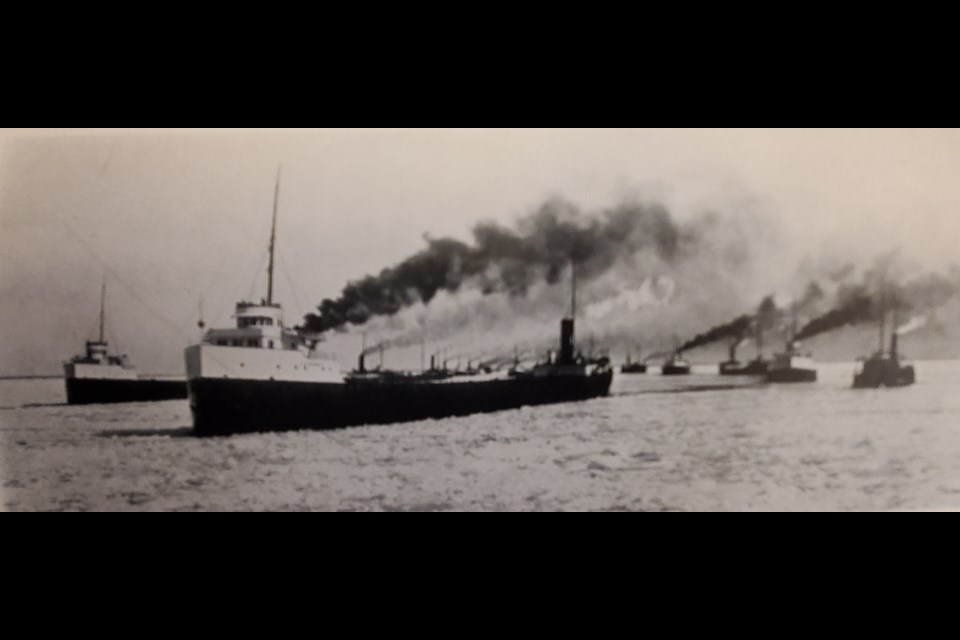From the archives of the Sault Ste. Marie Public Library:
It has often been said of the Sault and area that if you don’t like the weather just wait five minutes and it will change! No one has probably wished that to be so more than the British physician and geologist J.J. Bigsby or the seamen who traversed the area’s waterways.
In the summer of 1824, as a passenger aboard “his Majesty’s schooner Confiance, then employed in transporting from place to place the officers of the British Boundary Commission,” Bigsby recorded in his observations of the Lake Huron area, The Shoe and Canoe, that “We remained for three weeks at Encampment Douce, where our tents were thirteen in number, on a sandy point, near a perpendicular rock. The heat was intense (109.5 degrees Fahrenheit in the shade on two occasions) . . . and we were devoured with mosquitos.”
Encampment Douce, which lay “at the foot of the East Nibish Rapids, on the south point of St. Joseph and the islets on its east” is currently known as Sailor’s Encampment.
109.5 degrees Fahrenheit translates to 43.05 degrees Celsius. Regardless of the form of temperature measurement, it was ‘hot, hot, hot!’ on the shores of the North Channel that day. To add some perspective, our highest local temperature this summer for the month of July 2020 was 32 degrees Celsius or 89.6 degrees Fahrenheit, which is considered heat wave conditions in our northern climate.
Bigsby and his companions were suffering through almost 20 degrees Celsius more heat without the modern day comforts of air conditioning and refrigeration. One can only imagine the impact of the humidity upon the temperature and travelling party alike.
Not to be outdone by the heat of 1824, the fall of 1926 provided a sharp and cold contrast. The North Channel and St. Mary’s River by authors Gutsche,
Chisholm and Floren highlighted a local maritime and weather event, the Big Blockade of 1926. As the shipping season came to a close, “Captains paced nervously. It was November 30 and their shipping insurance was going to expire at midnight. As soon as they were loaded, twenty-two bulk freighters dashed toward the Sault. Despite their silent prayers, Mother Nature turned against them.”
“As ships began to converge in the St. Mary’s River, the thermometer plummeted and thick ice formed rapidly around Coulee, a steamer wedged across the rock cut beside Neebish Island. Behind her, sixty ships were blocked and shortly gripped by ice. “
These ice trapped ships represented millions of dollars in losses for the shipping companies and wreaked havoc in the Midwest grain markets of Chicago.
“As the days passed, the channels became more and more congested. At night, the river shimmered as the miles of lights transformed the St. Mary’s River into a cityscape. “ Such a sight would rival today’s nightscape of the bridge and city lights of the twin Saults.
Working during frigid temperatures with equipment that would have been hampered by the sheer volume of ice “exhausted tugboat crews worked to free the vessels from 4 a.m. to 11 p.m . . . no sooner would a ship be freed than the ice would imprison it again.“
Finally, “after two weeks the ice-crushing ferry from Michigan finally arrived to open the channel . . . 149 downbound ships and 98 upbound ships had been freed.”
Much like the tragic sinking of the Edmund Fitzgerald and the ‘gales of November’, The Big Blockade of 1926 came to be the benchmark by which sailors of that era came to measure their tests and trials at the hands of our inland seas.
From inferno to ice, this land we call home continues to illustrate the extreme moods of Mother Nature.
Each week, the Sault Ste. Marie Public Library and its Archives provides SooToday readers with a glimpse of the city’s past.
Find out more of what the Public Library has to offer at www.ssmpl.ca and look for more Remember This? columns here
